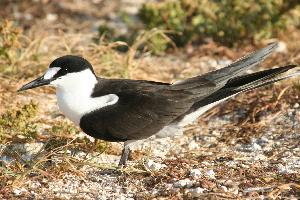
State of endangerment
| Endangered |
Animal description
The Arctic tern (Sterna paradisaea) is a remarkable and fascinating bird species known for its extraordinary migratory journey, the longest of any animal in the world. This small, agile seabird is part of the tern family, which encompasses various species known for their fishing prowess and distinctive flight patterns. The Arctic tern stands out not only for its migration but also for its elegant appearance and remarkable adaptability to some of the planet's most extreme environments.Physically, the Arctic tern has a slender body that measures about 33 to 39 centimeters in length, with a wingspan ranging from 76 to 85 centimeters. It is characterized by its light, streamlined frame, which facilitates its long-distance flights. The bird exhibits a predominantly silvery-grey plumage, with a stark white underside that helps it blend into the Arctic skies and seas. Its cap is a deep black, contrasting sharply with its pale body, and it has a pointed, red bill and short, red legs, adding a splash of color to its otherwise monochrome appearance. During the breeding season, the Arctic tern's bill and legs become even more vividly colored, a trait thought to be attractive to potential mates.
One of the most striking features of the Arctic tern is its migration pattern. Each year, this bird undertakes an incredible journey from its breeding grounds in the Arctic and sub-Arctic regions to the Antarctic and back, covering a distance of approximately 71,000 kilometers (about 44,000 miles). This extensive travel ensures that the Arctic tern sees more daylight than any other creature on Earth, experiencing two summers annually. The reason behind this extraordinary migration is primarily to exploit the abundant feeding opportunities in these nutrient-rich waters and to escape the harsh Arctic winter.
Arctic terns are supremely adapted to life on the wing. Their long, narrow wings and streamlined bodies allow them to glide effortlessly over vast distances, conserving energy. During their migration, they are known to fly close to the water's surface, catching fish and small marine invertebrates with remarkable precision. They employ a hunting technique known as "hovering," where they remain almost stationary in the air before diving headfirst into the water to catch their prey.
Breeding is a critical period in the life of an Arctic tern. They form colonies on coasts and islands, laying one to three eggs in a nest that is little more than a shallow scrape in the ground. Both parents share the responsibility of incubating the eggs and feeding the hatchlings. The breeding sites are chosen for their inaccessibility to predators, and the terns are fiercely protective of their nesting area, often attacking larger birds and even humans who venture too close.
Despite their widespread range and large population, Arctic terns face threats from climate change and habitat loss. The warming of the planet affects the availability of their prey, while human activities encroach on their breeding and feeding grounds. Conservation efforts are crucial to ensure that these remarkable birds can continue their epic migrations for generations to come.
In summary, the Arctic tern (Sterna paradisaea) is an extraordinary avian species, distinguished by its unparalleled migratory journey, elegant appearance, and remarkable adaptations to a life spent mostly in the air. Its annual odyssey from pole to pole is not just a testament to the bird's endurance but also a reflection of the interconnectedness of the Earth's ecosystems.
Map of occurrence

Similar Animals
New photos of animals
Top 10 animals
- Dolphin gull (Leucophaeus scoresbii)
- Diana monkey (Cercopithecus diana)
- Moustached guenon (Cercopithecus cephus)
- Galápagos tortoise (Geochelone nigra complex)
- Stone loach (Barbatula barbatula)
- Greek tortoise (Testudo graeca)
- Japanese macaque (Macaca fuscata)
- Russian tortoise (Testudo horsfieldii)
- Common flying dragon (Draco volans)
- Galápagos penguin (Spheniscus mendiculus)


